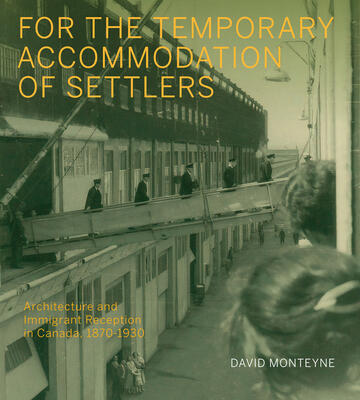
For the Temporary Accommodation of Settlers
Architecture and Immigrant Reception in Canada, 1870-1930
An architectural history of the buildings that welcomed, directed, controlled, and rejected immigrants.
Description
For immigrants making the transoceanic journey from Europe or Asia to North America, the experience of a new country began when they disembarked. In Canada the federal government built a network of buildings that provided newcomers with shelter, services, and state support. "Immigration sheds" such as Pier 21 in Halifax – where ocean liners would dock and global migrants arrived and were processed – had many counterparts across the country: new arrivals were accommodated or incarcerated at reception halls, quarantine stations, and immigrant detention hospitals.
For the Temporary Accommodation of Settlers reconstructs the experiences of people in these spaces – both immigrants and government agents – to pose a question at the heart of architectural thinking: how is meaning produced in the built environments that we encounter? David Monteyne interprets official governmental intentions and policy goals embodied by the architecture of immigration but foregrounds the unofficial, informal practices of people who negotiated these spaces to satisfy basic needs, ensure the safety of their families, learn about land and job opportunities, and ultimately arrive at their destinations. The extent of this Canadian network, which peaked in the early twentieth century at over sixty different sites, and the range of building types that comprised it are unique among immigrant-receiving nations in this period.
In our era of pandemic quarantine and migrant detention facilities, For the Temporary Accommodation of Settlers offers new ways of seeing and thinking about the historical processes of immigration, challenging readers to consider government architecture and the experience of migrants across global networks.
Awards
- Winner, The John Brinckerhoff Jackson Book Prize 2022
- Winner, Abbott Lowell Cummings Award 2022
Reviews
“Monteyne deftly moves from close analysis of visual material to a wide array of voices found in memoirs, letters, internal departmental correspondence, and parliamentary debate. His introduction situates his work within vernacular architectural studies and frames his study wisely around Henri Lefebvre’s theory of space. Indeed, by invoking Lefebvre he establishes a broad field of important players, including not only government officials and the buildings themselves, but also the migrants who briefly inhabited the sites. This creates a richly textured study of the best kind in architectural history – one that allows readers to imagine the use and longer life of these spaces in an evocative and thought-provoking manner. We come away with an understanding of the intentions behind the design of the sites, the experience of them, the shortcomings of the architecture, and the way buildings were adapted and developed over time to meet changing needs.” Michael Windover, author of Art Deco: A Mode of Mobility
"This book is sure to shape future studies not only of immigration architecture or institutional architecture broadly but also of the ways in which architecture acquires meaning. Highly recommended." Choice
“For the Temporary Accommodation of Settlers will appeal to a wide readership. Scholars of architectural history and vernacular landscape studies will be attracted to the book’s methodological rigour and its attention to a set of understudied building types, as will scholars of Canadian studies. The topic is timely and will reach readers eager to bring an understanding of history to bear on current debates about illegal immigration and concerns about policing national borders; a chapter on the lived experience of those detained in nineteenth-century quarantine stations has specific resonance in troubling times.” Abigail A. Van Slyck, A Manufactured Wilderness: Summer Camps and the Shaping of American Youth, 1890–1960